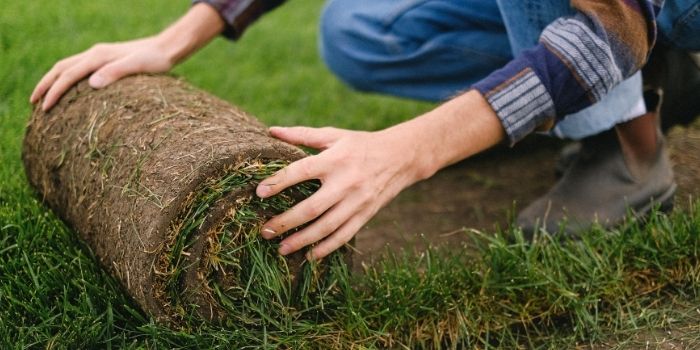If you have a nice-looking lawn that is pleasant underfoot but still feels spongy or squishy, it’s because your grass’s root structure is likely quite shallow.
In most situations, an excessive buildup of aged and decaying grass fibers is the cause of your lawn’s fluffy and spongy appearance. A lot of growth in the preceding years can cause a build-up of excess lawn runners in your turf.
These runners die eventually, and additional grass attempts to grow on top of them. This can limit the amount of oxygen and water reaching the plant’s roots. This gives your lawn a carpet-like appearance.
To get rid of this and recover your lawn to its previous soft, green state, dethatch it with a lawn dethatcher.
Simple Dethatching Steps to Fix The Lawn
The first step in addressing a spongy or squishy lawn is to remove excess thatch. Dethatching is best done in the early spring and late summer for cool-season grasses and late spring for warm-season grasses.
It’s also a good idea to dethatch immediately before or during the accelerated growth that is frequent in lawns everywhere.
Use a strong tines thatch rake or an electric dethatcher machine to remove the top layer of thatch. Use dethatching equipment if the thatch is thicker than 12 inches.
Go over the entire yard or area, then do it again from the opposite direction. Once thatch or surface debris is removed, bag it and discard it. You can also use this thatch in your compost pile.
This should fix the difficulties with squishy or spongy lawns. However, if the issue continues, you may require drainage assistance to channel the flow of water on your land to avoid settling in your grass.
Add and Repair Drainage Line
Adding a drainage ditch with a corrugated drainage pipe is a simple solution to redirect the excess water running across your lawn.
Keep in mind that water will move downhill, so plan ahead of time where you want to capture the water and where it will eventually be redirected to. Maintain a modest dip in your drainage line.
If you’ve dethatched your lawn and fixed any probable drainage problems but still have a squishy or spongy lawn, consider aerating it.
Try Aeration For The Lawn
The major benefit of lawn aeration is that it enhances soil drainage, allows it to dry out between waterings, and restores the desired firmness to the ground. Both core aeration and liquid aeration help to improve drainage.
They also help in supplying nutrients and oxygen to the grass’s root zones. Core aeration is a useful first step since it has a quick and immediate effect by removing the core plugs and exposing the soil to air.
Liquid aeration is an excellent option for continuous lawn management. It can work on every square inch of the lawn and not just the regions directly close to core aeration plugs.
Let’s look into the fact what kind of damage thatch can cause to your lawn and how you can reduce it.
Damages Caused By Thatch Buildup
Excessive thatch can block moisture from reaching the soil, resulting in dry spots. It also stays wet for an extended period, which can lead to disease and shallow root growth in the grass.
Brown patch, leaf spot, dollar spot, and stripe smut are more likely to grow in a lawn with dense thatch buildup than in grass with less thatch. Thatch keeps fertilizer from reaching the roots and can develop chlorosis.
As air cannot circulate as a result excessive carbon dioxide is produced. It creates an ideal environment for microbes that limit the grass’s ability to absorb nutrients.
Crown lift can also occur and make the grass susceptible to harm from cold, heat, drought, scalping, and foot activity. It can even alter the pH of the soil.
How to Reduce The Thatch
Adding less fertilizer than previously and watering just as needed to maintain the grass green aid in the prevention of thatch buildup. Every year, most grasses require 4 pounds of nitrogen fertilizer per 1,000 square feet of the ground.
For warm-season grasses, that amount of fertilizer should be divided into four treatments, two in late spring and two in early fall, four weeks apart.
For cool-season grasses, the amount of fertilizer should be divided into three applications: once in mid-spring and again in early fall.
Allow the soil to dry to a depth of 2 inches before watering the grass, and then water it until the soil is soaked to a depth of 6 to 8 inches. The amount of water required varies depending on the grass type, soil composition and weather.
Take Care of The Lawn After Dethatching
You can follow some steps for optimum results after dethatching. Try overseeding after any dethatching round. It will undoubtedly aid in restoring your lawn’s natural, verdant, and lush appearance.
We recommend testing your soil at least every 3 – 4 years to avoid more thatch concerns. Also, make sure to stick to soil test standards to maintain optimal soil nutrients and pH levels.
Make sure to fertilize your grass according to the soil test results. Just don’t over-fertilize, or you’ll end up back where you started.
The same goes for watering and mowing the yard. To promote growth and avoid thatch issues, you’ll need to do it correctly. Water the yard enough, but not too much.
Final Verdict
It is possible that several factors have colluded to create a muddy mess in your otherwise lovely lawn. It is treatable by a series of particular steps and should not be overlooked.
Allowing the grass to be mushy and spongy can result in a muddy mess at certain times of the year at best, and could result in someone harming themselves when walking on the soft ground.
Dethatch your lawn, improve soil drainage and maintain good water management using a drain line if needed to keep your lawn from turning back into a wet and soggy, muddy mess that is sticky and spongy to walk on.
FAQs
Q. Why is spongy grass bad for your lawn?
A: Although walking on a spongy lawn feels pleasant, it may easily result in several problems for your lawn because of the grass’s reduced ability to absorb water, nutrients, and oxygen from the soil.
Q. How often should you dethatch your lawn?
A: Since thatch grows over time, it is not required to dethatch every year. If your lawn requires it, dethatching should be done every five years or so.
Q. Should I start by aerating or dethatching?
A: Excessive thatch prevents air, light, and water from reaching the root zones. Aeration and dethatching services go hand in hand. First, dethatch, then aerate.

